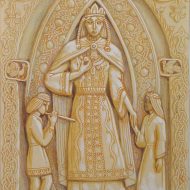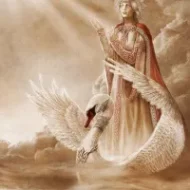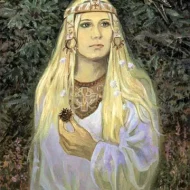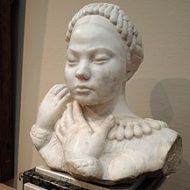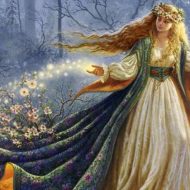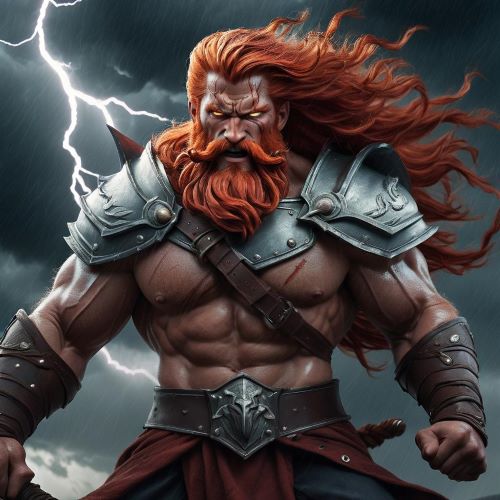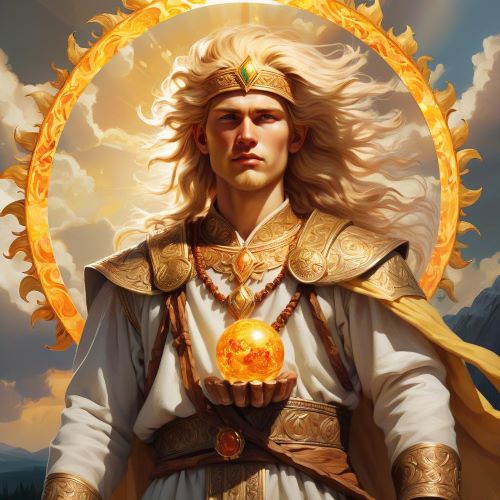Lada : Goddess of Love
Listen
At a glance
| Description | |
|---|---|
| Origin | Slavic Mythology |
| Classification | Gods |
| Family Members | Lado (Husband/Brother) |
| Region | Ukraine, Poland |
| Associated With | Beauty, Love |
Lada
Introduction
Lada, a charming Slavic and Latvian-Lithuanian goddess known for her special connection to fertility and marriage. Her influence was so widespread, especially in Ukraine, that it left an indelible mark on the songs and rituals of the region. The earliest written mentions of the Lada cult date back to the 15th century, when Polish church authorities were putting a stop to pagan practices. In Ukraine, you can find references to Lada in Innokentii Gizel’s Sinopsis, penned in 1674, where she’s described as a goddess hailing from the time of Volodymyr the Great. People used to celebrate Lada’s festival with lively games in her honor, making it an integral part of their springtime rituals.
In the rich tapestry of Slavic mythology, the enchanting goddess Lada has long been likened to her counterparts in the North, Freyja, and in the ancient Greek pantheon, Aphrodite. These esteemed goddesses all embody the essence of beauty, the promise of spring, and the renewal that follows the winter’s end.
Yet, in a twist of scholarly revelation, there arises a provocative notion that challenges Lada’s origins. Some modern research posits that Lada may not have been an authentic pre-Christian Slavic deity at all. Instead, she might have emerged as a creation of anti-pagan clerics during the 15th and 16th centuries. These clerics, drawing inspiration from Byzantine, Greek, or Egyptian narratives, could have woven tales of Lada with the intent of diminishing the cultural significance of pagan traditions. This perspective invites us to reexamine the narratives surrounding Lada, highlighting the complex interplay between ancient belief systems and the influence of later religious interpretations.
Physical Traits
In the world of myth and legend, Lada emerges as a captivating vision of womanhood. She is often depicted as a voluptuous figure, radiating the vitality of life itself. Her wavy golden locks cascade around her, framing her features, and her skin is as fair as fresh snow. Her curves, full and alluring, carry the unmistakable aura of maturity and motherhood. Lada is a symbol of divine beauty, a timeless embodiment of eternal youth.
In the lyrical verses of Russian folk songs and the pages of enchanting tales, Lada’s presence is described with reverence. She is a gracious and resplendent figure, her golden hair gleaming like sunlight, and a regal crown rests atop her head, a symbol of her divine status. In these narratives, Lada’s image evokes a sense of awe and admiration, capturing the essence of beauty and fertility in its most sublime form.
Family
In other renditions of the mythos, Lada and Lado come together, forming a divine pair. They are often viewed as celestial twins, a harmonious duality that complements each other’s existence. While some interpretations present them as mother and son, their unity transcends traditional familial boundaries. Instead, it can be seen as a representation of a multi-faced deity, one that encompasses the domains of the Sun, water, and grain. This complexity mirrors the intricate interplay of forces in the natural world, where harmony, order, and beauty are celebrated as essential elements of life’s tapestry.
Other names
The resonance of the name “Lad” carries significant meaning in various Slavic languages. In Czech, it signifies “harmony, understanding, order,” while in Polish, it conveys the essence of “order, beauty, and charm.” This linguistic connection hints at the profound role that Lada plays in Slavic mythology.
Powers and Abilities
In the rich tapestry of Slavic myths, Lada emerges as a multifaceted figure. In some accounts, she assumes the esteemed mantle of the mother goddess, representing the pinnacle of femininity and the embodiment of human desires and passions. She is the supreme female deity, presiding over the realm of eroticism and longing. Lada is the vernal goddess of love and fertility, overseer of the harvests, protector of lovers, couples, marriage and family, women and children.
Modern Day Influence
The talented Russian painter Maximilian Presnyakov honored Lada in his “Slav cycle” series in 1998. His portrayal captured her as a radiant woman, graced with golden hair and adorned with delicate flowers. Additionally, Russian sculptor Sergey Timofeyevich Konenkov crafted a statue of Lada in 1971, depicting her as a voluptuous figure crowned with wheat, symbolizing abundance and fertility.
Lada extends her influence into the world of gaming, becoming a playable character in the video game “Smite,” a multiplayer online battle arena game featuring deities from various mythologies. In “Smite,” she assumes the role of a mage, wielding powers of love and fertility to heal allies and beguile foes. Furthermore, Lada makes a cameo appearance in the video game “The Witcher 3: Wild Hunt,” an RPG based on Andrzej Sapkowski’s novels. Within the game, she is revered by the Skellige people, symbolizing beauty, love, and marriage.
Related Images
Frequently Asked Questions
What is lorem Ipsum?
I am text block. Click edit button to change this text. Lorem ipsum dolor sit amet, consectetur adipiscing elit. Ut elit tellus, luctus nec ullamcorper mattis, pulvinar dapibus leo.
What is lorem Ipsum?
I am text block. Click edit button to change this text. Lorem ipsum dolor sit amet, consectetur adipiscing elit. Ut elit tellus, luctus nec ullamcorper mattis, pulvinar dapibus leo.
What is lorem Ipsum?
I am text block. Click edit button to change this text. Lorem ipsum dolor sit amet, consectetur adipiscing elit. Ut elit tellus, luctus nec ullamcorper mattis, pulvinar dapibus leo.
What is lorem Ipsum?
I am text block. Click edit button to change this text. Lorem ipsum dolor sit amet, consectetur adipiscing elit. Ut elit tellus, luctus nec ullamcorper mattis, pulvinar dapibus leo.
What is lorem Ipsum?
I am text block. Click edit button to change this text. Lorem ipsum dolor sit amet, consectetur adipiscing elit. Ut elit tellus, luctus nec ullamcorper mattis, pulvinar dapibus leo.

